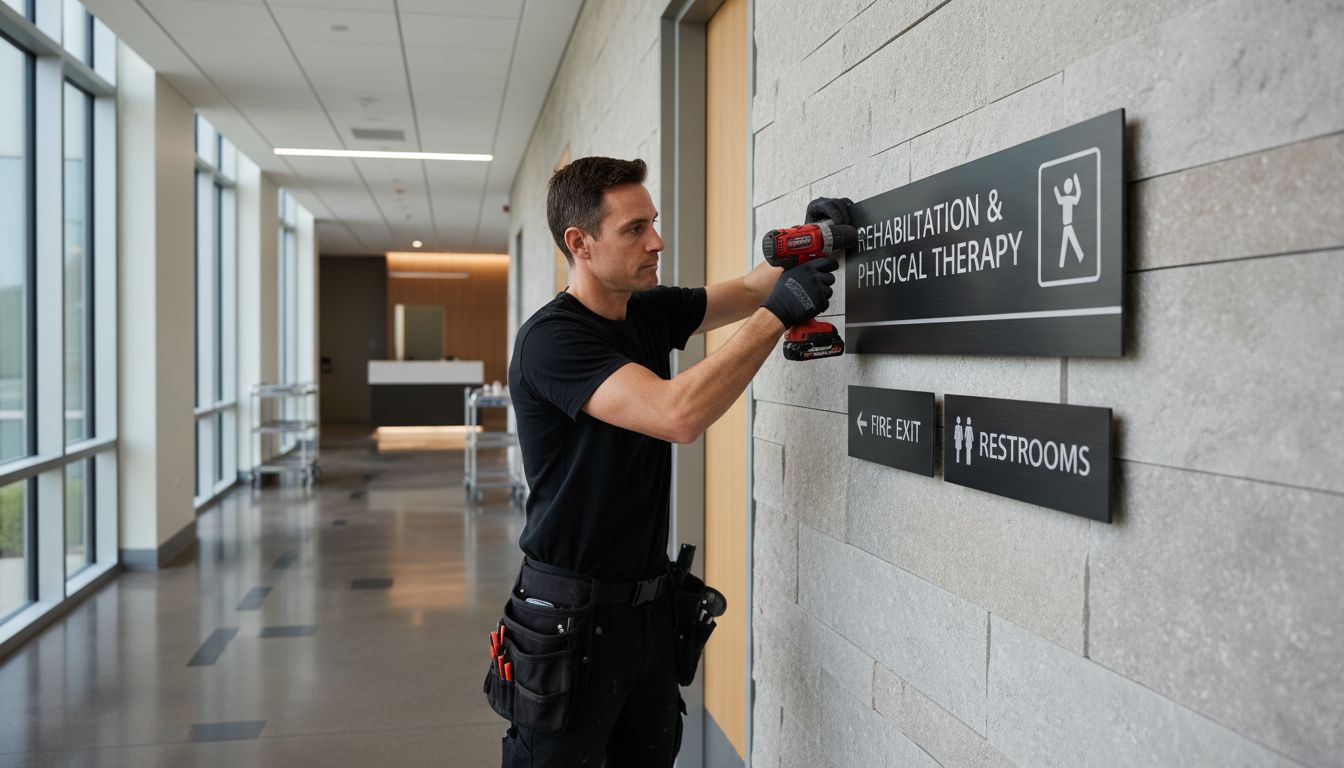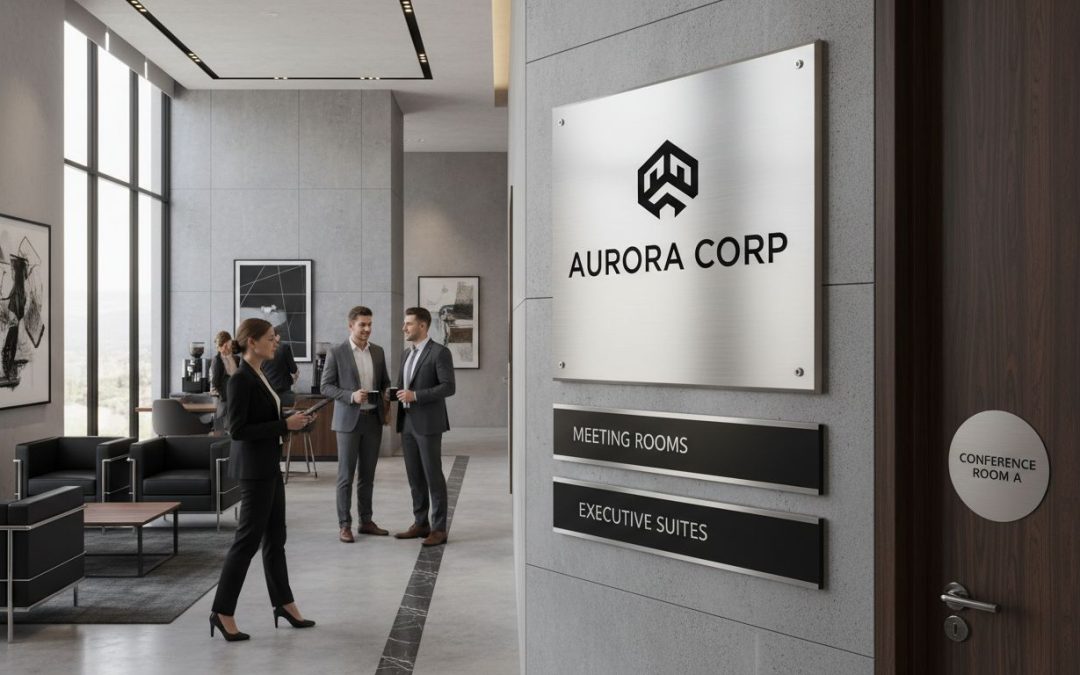{
“@type”: “Article”,
“author”: {
“url”: “https://customsignstoday.us”,
“name”: “Customsignstoday”,
“@type”: “Organization”
},
“@context”: “https://schema.org”,
“headline”: “What Is Engraved Signage? Complete Overview for 2025”,
“publisher”: {
“url”: “https://customsignstoday.us”,
“name”: “Customsignstoday”,
“@type”: “Organization”
},
“inLanguage”: “en”,
“description”: “Engraved signage explained: types, production methods, key features, business uses, and cost factors. A comprehensive guide for professionals in 2025.”,
“datePublished”: “2025-11-18T02:53:24.065Z”
}
Over 80 percent of businesses rely on some form of permanent signage to guide, inform, or impress their customers. Choosing the right type can set the tone for your brand and ensure messages stand the test of time. Engraved signage stands out for its lasting durability and elegant look, making it a top choice across industries. This guide breaks down what engraved signs are, how they work, and why they keep winning trust in professional spaces.
Table of Contents
- Defining Engraved Signage and Its Uses
- Types of Engraved Signs and Materials
- How Engraving Processes Work
- Key Benefits for Businesses and Events
- Costs, Durability, and Design Considerations
Key Takeaways
| Point | Details |
|---|---|
| Durability and Longevity | Engraved signage is a long-term investment, offering superior durability that maintains clarity for years compared to printed signs. |
| Material Versatility | Various materials, including metals, plastics, and natural materials, provide options that meet diverse aesthetic and functional needs. |
| Precision in Design | Modern engraving techniques ensure precise detailing, allowing for intricate and visually impactful signage across different applications. |
| Professional Appearance | The sophisticated nature of engraved signage enhances brand perception, making it ideal for business and public environments. |
Defining Engraved Signage and Its Uses
Engraved signage represents a sophisticated method of creating visual communication through precise cutting or etching designs into hard surfaces. According to Wikipedia, engraving is fundamentally “the practice of incising a design on a hard, usually flat surface by cutting grooves into it with a burin”. This technique transforms ordinary materials into informative and visually striking communication tools.
Engraving techniques allow businesses and organizations to create durable, professional signs with incredible precision. By cutting or carving designs directly into materials like metal, wood, glass, or stone, engraved signage offers a permanent and elegant way to display information. Unlike printed signs that can fade or wear out, engraved signs maintain their crisp appearance and legibility for years, making them an excellent investment for long-term visual communication.
The versatility of engraved signage makes it applicable across numerous settings. Custom Signs Today offers solutions for various environments, including:
- Corporate office identification plates
- Directional and wayfinding signs
- Memorial and commemorative markers
- Professional building nameplates
- Industrial safety and warning signs
- Architectural and decorative signage
Particularly in professional and public spaces, engraved signs communicate a sense of permanence and quality. As Wikipedia notes with interpretive signs, these communication tools are not just about displaying information, but also about creating a meaningful visual experience that guides and informs viewers effectively.
Types of Engraved Signs and Materials
Engraved signage comes in a remarkable variety of materials, each offering unique characteristics and aesthetic qualities. According to Almetek, sign materials range from aluminum to reflective surfaces, providing businesses and organizations with multiple options for creating durable and visually appealing communication tools.
Metal Engraving Materials represent the most popular and robust category of engraved signage. Aluminum, brass, stainless steel, and bronze are frequently used due to their durability, resistance to weathering, and professional appearance. These materials allow for deep, precise etching that maintains crisp detail and legibility for decades. Outdoor signs guide highlights how metal engraving can create everything from sleek corporate nameplates to rugged industrial safety markers.
Specialty materials offer fascinating alternatives for unique signage needs. Wikipedia introduces Traffolyte, a multi-layered phenolic plastic sheet that enables stunning color contrast in engraved designs. This material allows for intricate, color-differentiated engravings that can add visual complexity to signs.
The primary types of engraved sign materials include:
- Metals: Aluminum, brass, stainless steel, bronze
- Plastics: Acrylic, traffolyte, ABS, polycarbonate
- Natural Materials: Wood, stone, marble
- Specialty Surfaces: Glass, ceramic, porcelain
Each material brings unique advantages, from the industrial strength of metals to the decorative potential of glass and wood.
![]() The choice depends on the specific environment, aesthetic goals, and functional requirements of the signage project.
The choice depends on the specific environment, aesthetic goals, and functional requirements of the signage project.

How Engraving Processes Work
Engraving is a precise and intricate process that transforms flat surfaces into detailed communication tools. According to Wikipedia, the fundamental technique involves “incising a design on a hard surface by cutting grooves into it with a burin”, a specialized tool that has been critical in artistic and informational applications throughout history.
Modern engraving processes leverage both traditional and advanced technological methods. Mechanical engraving uses precision cutting tools like computer numerical control (CNC) machines that can create incredibly detailed designs with microscopic accuracy. These machines can engrave intricate patterns, text, and graphics onto various materials by precisely removing surface material through cutting, etching, or abrading. Design business signs guide emphasizes how technological advancements have dramatically improved the precision and complexity of engraved signage.
Specialty techniques like photosensitive engraving offer innovative alternatives to traditional methods. As Wikipedia explains, this process utilizes the porous nature of materials like anodized aluminum to create sub-surface images through sophisticated chemical and photographic techniques. This method allows for extremely detailed and durable designs that can be integrated directly into the material’s surface.
The primary engraving techniques include:
- Mechanical Engraving: Using precision cutting tools
- Laser Engraving: Using high-powered lasers to etch designs
- Chemical Etching: Removing material through controlled chemical processes
- Photosensitive Engraving: Creating designs through light-sensitive chemical reactions
- Hand Engraving: Traditional method using specialized hand tools
Each technique offers unique advantages, allowing businesses and designers to select the most appropriate method based on material, design complexity, and desired aesthetic outcome.
Key Benefits for Businesses and Events
Engraved signage offers businesses and event organizers a powerful communication tool that combines durability, professionalism, and visual impact. As Wikipedia explains, this technique allows for creating “decorated objects” that can produce detailed and lasting visual communication, making it an ideal solution for various professional settings.
Durability and Longevity stand out as primary advantages of engraved signage. Unlike printed signs that fade or wear out quickly, engraved signs maintain their crisp appearance and legibility for years, providing a long-term investment for businesses. The permanent nature of the design means organizations can create signs that withstand harsh environmental conditions, from intense sunlight to heavy foot traffic. Outdoor event signs guide highlights how this durability makes engraved signs particularly valuable for outdoor and high-traffic environments.
From an informational perspective, engraved signs excel at providing clear, interpretative communication. Wikipedia notes that such signs can “provide information via text, photographs, and artwork about an area, enhancing visitor experience”. This makes them invaluable for businesses and events seeking to create meaningful, engaging visual communication.
Key benefits of engraved signage include:
- Exceptional durability and long-term cost-effectiveness
- Professional and sophisticated visual appearance
- Resistance to weathering and environmental damage
- Precise, crisp detailing of text and graphics
- Versatility across different materials and settings
- Enhanced brand perception and visual communication
Whether for corporate environments, event spaces, or public venues, engraved signage offers a compelling blend of aesthetic appeal and practical functionality that can elevate any communication strategy.
Costs, Durability, and Design Considerations
Navigating the complex landscape of engraved signage requires careful consideration of multiple factors that impact overall value and effectiveness. Almetek provides critical insights into sign materials, emphasizing how material selection directly influences durability, cost, and long-term performance.
Material Selection represents the most significant factor in determining both initial investment and ongoing value. Different materials offer varying price points and durability characteristics. Aluminum and stainless steel, while slightly more expensive upfront, provide exceptional longevity and minimal maintenance requirements. Personalized signage guide suggests that businesses should view engraved signage as a long-term investment, where higher initial costs can translate to reduced replacement expenses.
Wikipedia reveals interesting historical context about material considerations, noting that while some traditional materials like traffolyte were once cost-effective, modern safety and performance standards require more sophisticated approaches. Contemporary engraving materials must balance aesthetic appeal, durability, safety, and budget constraints.
Key design and cost considerations include:
- Initial material and production costs
- Expected lifespan of the signage
- Environmental exposure and durability requirements
- Complexity of design and engraving technique
- Maintenance and potential replacement expenses
- Aesthetic and branding alignment
Successful engraved signage projects carefully weigh these factors, ensuring that the final product not only meets functional requirements but also provides optimal long-term value for businesses and organizations.
Discover the Lasting Impact of Customized Engraved Signs for Your Business
Engraved signage offers unmatched durability and professional appeal, making it the perfect solution for businesses seeking clear, long-lasting communication. If you are concerned about signs that fade or wear out quickly, or if you want to elevate your brand with elegant, permanent visual displays, then engraved signs are the answer. With options ranging from metals like aluminum and brass to specialty materials, your signs can withstand weather and daily wear, ensuring your message remains sharp and impactful.
Improve your space with custom options tailored to your environment and branding goals. Explore a wide range of professional signage solutions designed to meet your unique needs at Uncategorized.

Ready to invest in signage that lasts and impresses? Visit https://customsignstoday.us today to request a free quote and start designing your custom engraved sign. Take the next step now and transform your business’s visual communication with expert craftsmanship and durable materials.
Frequently Asked Questions
What is engraved signage?
Engraved signage is a method of creating informational signs by cutting or etching designs into hard surfaces like metal, wood, glass, or stone. This technique ensures durability and maintains legibility over time.
What materials are commonly used for engraved signs?
Common materials for engraved signs include metals like aluminum, brass, stainless steel, and bronze, as well as plastics such as acrylic and traffolyte, natural materials like wood and stone, and specialty surfaces like glass and ceramic.
What are the benefits of using engraved signage for businesses?
Engraved signage offers several benefits, including exceptional durability, resistance to environmental damage, a professional appearance, precise detailing, and enhanced brand perception, making it an excellent long-term investment for effective communication.
What engraving techniques are typically used in the production of engraved signs?
Common engraving techniques include mechanical engraving, laser engraving, chemical etching, photosensitive engraving, and traditional hand engraving. Each method allows for different levels of detail and complexity in the designs produced.

